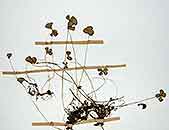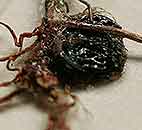Marsilea nubica A. Braun var. gymnocarpa (Lepr. ex A. Braun) Launert
Synonyms |
Marsilea gymnocarpa Lepr. ex A. Braun |
|---|---|
Common name |
|
Description |
Rhizome very slender, repeatedly branched, forming a widespread system, bearing fronds 0.5–2 cm apart. Floating form: stipe up to 18 cm long. Leaflets leaflets rather variable, from broadly obtriangular to very narrowly obtriangular, up to 35 mm long, outer margin uneven with shallow indentations, with short or long brown suberose streaks between the veins of the lower surface. Dry land form: stipe 1.5-6 cm long. Leaflets leaflets rather variable, from broadly obtriangular to very narrowly obtriangular, up to 7 mm long, outer margins entire to very shallowly irregular. Sporocarps: usually single, or crowded at stipe base; very glossy, shiny, dark red brown to black, with a few flattened scales when young becoming glabrous with age, smooth with minute dots, with the black outer layer becoming detached and peeling; broadly to narrowly deltate in lateral view, vertical cross-section elliptic; lower tooth absent, upper tooth a slight hump. Sporocarp with its long axis pointing downwards; pedicels up to 3 mm long, free, arising from the axil of the stipe. |
Notes | Characteristic for this species is the black, glossy sporocarps, with the outer layer peeling of at maturity. |
Derivation | nubica: from Nubia, from north-east africa (Sudan); gymnocarpa: naked fruit, outer layer of sporocarp peels of leaving it "naked" beneath. |
Habitat | Acacia or Mopane woodland, in sandy soils or fine clay accumulated in seasonally flooded pans, ponds and pools. |
Distribution worldwide | Africa, Madagascar. |
Distribution in Africa |
Angola, Botswana, Chad, Mali, Mauritania, Namibia, Senegal, Sudan and South Sudan, Tanzania , Zimbabwe. |
Growth form |
Aquatic, terrestrial. |
Literature |
|


